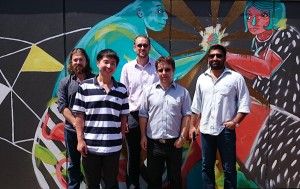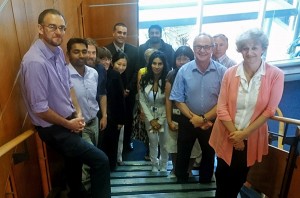Curtin Air Quality Research
During last year’s meeting of the Executive Committee of the Centre, Curtin participated as observers. At the Annual Meeting which was held in Brisbane on the 1 December 2015, Curtin signed the official agreement to become members of the ACC-AQSM. Since then, joint work activities have accelerated. In particular, Dr. Krassi Rumchev (CU) visited QUT and gave a presentation on the 11 February 2016. During her visit, the discussion centered on joint project planning and preparation of papers for the STOTEN Special Issue on Air Quality in China.
Curtin University has established expertise across a range of air pollution health areas including:
- assessing adverse health effects related to indoor and outdoor air quality,
- characterisation of exposures to ultrafine particulates in environmental and occupational settings,
- aerosol science,
- spatial epidemiology,
- computational fluid dynamics simulation of particle deposition in the lungs,
- genetics and epigenetic factors underlying asthma, and
- climate change and Health Impact Assessment and air quality sensing technology.
Curtin also has the TRACE Facility which is a unique, purpose-built, cleanroom environment designed for measuring extremely low concentrations of chemical species – either from ice-cores or particulate matter samples. The TRACE lab hosts a state-of-the-art High Resolution Inductively Coupled Plasma Mass Spectrometer (ICP-MS,  Thermo ELEMENT2) for the analysis of hyper-trace concentrations of elements including rare earth elements. In addition, Curtin have recently formed the Curtin Institute for Computation (CIC), which brings together Curtin’s stake in the Pawsey petascale supercomputing facility, and the Cisco Internet of Everything (IoE) Centre. The range of expertise and facilities at Curtin align well with the key research themes and objectives of the Australia – China Centre for Air Quality Science and Management and it is anticipated that Curtin will be able to provide a significant contribution to the operation and output of the Centre.
Thermo ELEMENT2) for the analysis of hyper-trace concentrations of elements including rare earth elements. In addition, Curtin have recently formed the Curtin Institute for Computation (CIC), which brings together Curtin’s stake in the Pawsey petascale supercomputing facility, and the Cisco Internet of Everything (IoE) Centre. The range of expertise and facilities at Curtin align well with the key research themes and objectives of the Australia – China Centre for Air Quality Science and Management and it is anticipated that Curtin will be able to provide a significant contribution to the operation and output of the Centre.
Curtin – together with CSIRO have launched a project to fit smart air quality sensors to buildings at Curtin, with data warehousing and analytics to be conducted using the Pawsey infrastructure.
Current Projects and collaborations with China on air quality
- Dr Gavin Pereira and A/Prof Brad Zhang currently collaborate in an international project that links Curtin University with Peking University (Prof Lu) and the China National Institute for Communicable Disease Control and Prevention. The project also involves collaboration with Yale University , the Californian EPA and the University of Queensland. The aim of the most recent project is to establish the association between ambient air pollution exposure and perinatal health outcomes in China.
- A/Prof Zhang also has collaborative research projects with Prof Wu from Xinxiang Medical University and Prof Lv from Zheng Zhou University.
- Prof Charlie Ironside has collaborations with Prof. Ni Haiqiao and Jiaoqing Pan from the, Institute of Semiconductors, Chinese Academy of Sciences, Beijing.
- A/Prof Ben Mullins and Dr Brown have collaborations with Dr Xiaobin XU, Dr Weili LIN, Dr Jing Ming and other researchers from the Key Laboratory for Atmospheric Chemistry, China Meteorological Administration (CMA).
- Prof Huxley and Dr Rumchev have additional collaborations with China on Air quality projects.
Members (in alphabetical order)
- Dr Helen Brown: Helen is an expert in Health Impact Assessment and Leads the WHO collaborating centre on HIA based at Curtin.
- Professor Lin Fritschi: Lin is an occupational epidemiologist interested in exposure of workers to carcinogens (e.g. diesel exhaust, solvents, asbestos) and ototoxic agents.
- Professor Rachel Huxley: Rachel is an epidemiologist expert in cardiovascular health and air quality.
- Professor Charlie Ironside: Charlie is an expert in sensor technology, who has previously commercialised a low cost CO2 sensor.
- A/Professor Ben Mullins: Ben is an aerosol scientist with a background in air quality measurement, control and modelling – including respiratory exposure modelling.
- Dr Gavin Pereira: Gavin is an epidemiologist expert in spatial and perinatal exposure studies.
- Dr Krassi Rumchev: Krassi is expert in environmental and occupational exposure assessment.
- A/Prof Brad Zhang: Brad is expert in asthma and allergy and the role played by environmental exposures (incl. air quality).

